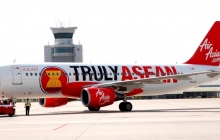AirAsia was launched in 2001 with the dream of making flying possible for everyone. Since then, AirAsia has swiftly risen to become the world’s best...
-

Textiles and Apparels
Where to invest?
Textile and Apparels
Towards stronger ASEAN vertical integration
The ASEAN Economic Community’s (AEC) implementation of a “single-window” common market system by 2015 has pushed the countries in the region to innovate and forge more partnerships with like-minded investors to create a vertical production network for the textiles industry. An integrated regional production network allows each country to focus on specific components, creating one ASEAN supply chain. Vertical integration means less competition among countries as the markets work towards harmonized production.
The ASEAN Federation of Textile Industries (AFTEX), a group of textile and garment associations of the 10 ASEAN member countries, has launched the Source ASEAN Full Service Alliance (SAFSA). SAFSA works on linking ASEAN apparel factories to create a virtual vertical supply chain between buyers, textile mills, and apparel factories, enabling businesses to offer a complete service package to international buyers.
SAFSA has 45 members trading among themselves including 27 buyers with over US$ 50 billion in annual apparel sales. Some of the major brands that are SAFSA customers are the Benetton Group, Colombia Sportswear Company, Debenhams, Guess, Marks & Spencer, Polo Ralph Lauren, and Hermes-OTTO.
ASEAN-wide exports
Textile is one of the largest export products from ASEAN, amounting to almost US$ 34.9 billion in 2022.1
Cambodia Leads AFTEX Consolidation Efforts Amid Textile Export Decline. Cambodia is taking a leadership role in the consolidation efforts of AFTEX (ASEAN Federation of Textile Industries) to strengthen the organization's role in advancing the textile and apparel industry in the ASEAN region. AFTEX participants are compiling a list of projects and work plans for the coming months under Cambodia's guidance.
These efforts are being made amidst challenging conditions for Cambodia's own textile industry, which experienced a 28.49% year-on-year decline in exports of "knitted or crocheted fabric" and a 40.80% decline on a semester basis (compared to the July-October 2022 period) in the first four months of 2023.2
Despite the export decline, Cambodia remains the second-largest exporter of textile categories in ASEAN in 2022, with export values reaching $6.32 billion, only below Vietnam with $17.32 billion and above Indonesia with $4.64 billion.3
Establishing global standards
Global Language Monitor 2019 ranked Singapore as the 8th fashion capital in the world, and 2nd in Asia, next only to Hong Kong. Singapore has become increasingly attractive to a rising number of inbound tourists for the variety of high-end international brands that can be purchased in the country. As Asian consumers become more affluent, Singapore engages in efforts to maintain its foothold as a fashion, and visitors to Singapore will find leading international fashion stores at Marina Bay.4
The shift towards creating a vertically integrated supply chain has attracted DuPont Imaging Technologies and Huntsman Textile Effects, which manufacture specialist chemicals and dyes for finished textiles to open centres in Singapore.
Meanwhile, Cambodia has established itself as a credible producer. The United Nations’ International Labor Organization independently monitors and reports on working conditions in the Cambodian textile factories according to local and international standards, which encourages companies like Levi’s, Gap, Sears, Wal-Mart, and Disney to choose Cambodia as their manufacturing hub.
The Ministry of Commerce (MOC) reported a net increase of 17 factories in the first half of 2017, bringing the total number of operational factories to 643 , with an average of 635,000 jobs per month in registered exporting factories. This growth was driven by the opening of 18 new factories, primarily in the garment sector (16), with only one closure (garment) offsetting some of the gains.5
References include the ASEAN Federation of Textile Industries and Investing in ASEAN by Allurentis.
[1]https://www.statista.com/statistics/1372983/asean-knitted-apparel-and-accessories-exports-by-country/
[3]https://www.statista.com/statistics/1372983/asean-knitted-apparel-and-accessories-exports-by-country/
-
Opportunities abound in the textile and apparel industry as ASEAN pushes for stronger integration. Countries in ASEAN can address every link in the complex supply chain of textiles and apparels. Some countries offer cost-competitive operations. Other countries excel in yarn production, fabric dyeing, and finishing while others focus on logistics, design, and marketing.
SUCCESS STORIES
-
- Site Map
- Terms & Abbreviations

